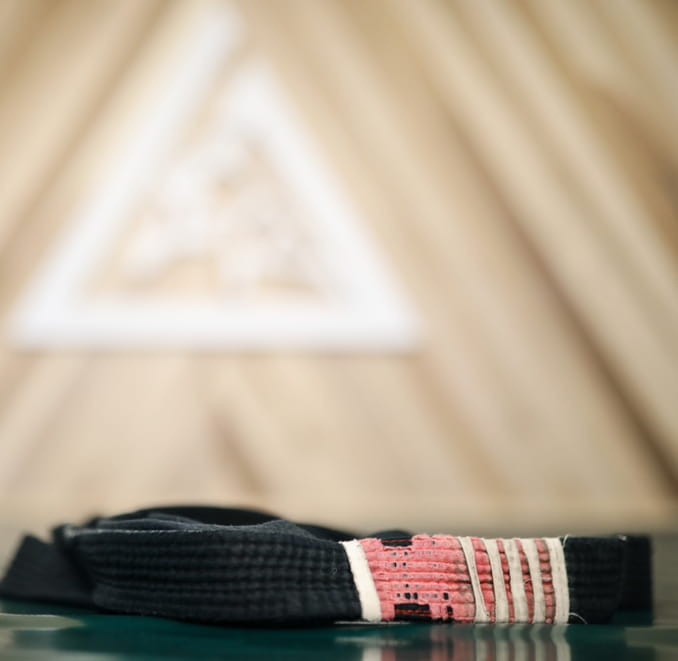The Jiu Jitsu Belt Trap
Training jiu-jitsu is like learning other skills. It does not take a lot of studying to understand the basics and to get to a point where you feel confident in your abilities. In fact, within just a few months of training you may feel as though you have a firm grip on many of the fundamentals that form the foundation of jiu-jitsu.
Though you may acquire an understanding of the basics somewhat quickly, it takes years to develop mastery of jiu-jitsu techniques. This doesn’t just come from learning the fundamental moves of the martial art. It comes from action. This means coming to class and putting in the reps, learning from others at the gym, and reflecting on what kinds of specific modifications you need to make to each technique to really make it your own. It’s a long and arduous process that can last a lifetime since you can always learn more and improve your jiu-jitsu.

What Belts Mean
Belts symbolize level of proficiency. A student with a white belt will have a lower level of proficiency than a student with a blue belt, a student with a blue belt will have a lower level of proficiency than a student with a purple belt, and so on. Moreover, these symbols should be thought of as milestones on one’s jiu-jitsu journey that each instructor awards when they feel a student has reached a certain level in training. Some instructors award belts based on how much time students put in. Some instructors award belts solely on students’ technical proficiency. Some instructors award belts based on students’ overall ability to fight.
To put it politely: There may be instances where a good white belt from one gym can regularly beat a blue belt from another gym. To put it diplomatically: There isn’t a standardized method for awarding belts. To put it bluntly: Belts don’t mean anything.
You Are Not Your Belt
In the below video, Ryan Young of Kama Jiu-Jitsu in Texas tells the story of how he got the opportunity to spar with a third-degree black belt no more than just a few days after he received his black belt from Master Dave Kama. Ryan was around the same weight and the same height as the guy. He was also still in his early forties and hadn’t faced any serious injuries, so he was confident that he’d be able to keep up, but he figured that he’d be outmatched by the other fighter.
To his surprise, they were pretty much evenly matched.
It turns out Master Dave had been holding out on awarding Ryan his black belt for over a year. As he later told Ryan, “I want you to be comfortable in your belt the day you get your belt.” In other words, though Ryan should have been wearing a black belt according to Master Dave’s standards, he didn’t Ryan to get it into his head that he was a black belt. He didn’t want Ryan defining himself by the color of his belt.
The Belt Trap
As Ryan explains in the video, he’s incorporated this kind of mentality in his own gym. He tends to wait to give people their belts. Critics of this kind of thinking may accuse him of sandbagging, but Ryan believes that he is making sure that his student is ready for the responsibilities of the belt in addition to showing the technical proficiency that is necessary to wear the belt.
Upon receiving a belt, many students will think of it as a ranking system. Moreover, they think about it categorically: If I am a blue belt, that means I can beat every white belt. This can be a dangerous mindset for some people who have only recently received a belt, especially new blue belts. As Ryan says, “If you have that mentality where you have to beat every white belt, you’re going to come across white belts that are good that you cannot beat, and that’s going to bring you down if you’re not thinking correctly. You’re going to tell yourself, ‘What the hell am I wearing this blue belt for.’”
That kind of self-doubt can force students to feel they have to prove themselves, and that it’s shameful to lose to a lower belt—even in cases where they only recently were the same belt color. This kind of mindset can make coming to jiu-jitsu class increasingly tense and stressful. Eventually, it might become unpleasant enough so that they stop coming to class and quit jiu-jitsu altogether.
Recognizing Your Goals
There is a right way to learn jiu-jitsu, largely because people decide to take it up for different reasons. Some prioritize self-defense. Some prioritize getting in shape. Some dream of one day fighting in MMA championships. There is no correct path.
What all jiu-jitsu students should remember is that the belt system is subjective and that it is an approximation of your skills. It is based on your instructor’s assessment of your abilities, and different instructors will use different metrics. More importantly, fixating on the color of your belt can become a trap, especially if your goal is just to learn self-defense. The important thing is to focus on becoming better than you were the day before and to keep learning and growing.

